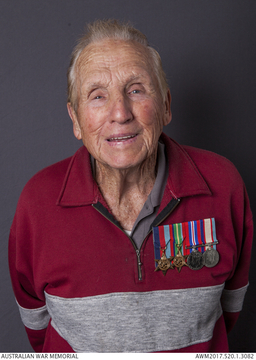HIGGINS, George Oliver
| Service Number: | SX19594 |
|---|---|
| Enlisted: | 11 May 1943 |
| Last Rank: | Private |
| Last Unit: | 2nd/3rd Field Regiment |
| Born: | Port Wakefield, South Australia, 27 January 1925 |
| Home Town: | Gawler, Gawler, South Australia |
| Schooling: | Not yet discovered |
| Occupation: | Not yet discovered |
| Died: | Natural Causes, Enfield, South Australia , 21 October 2022, aged 97 years |
| Cemetery: | Not yet discovered |
| Memorials: | Gawler Council WW2 Honour Roll |
World War 2 Service
| 11 May 1943: | Involvement Gunner, SX19594 | |
|---|---|---|
| 11 May 1943: | Enlisted Wayville, SA | |
| 11 May 1943: | Enlisted Australian Military Forces (WW2) , Private, SX19594, 2nd/3rd Field Regiment | |
| 8 Feb 1946: | Discharged | |
| 8 Feb 1946: | Discharged Australian Military Forces (WW2) , Private, SX19594, 2nd/3rd Field Regiment | |
| Date unknown: | Involvement |
VETERAN SURVIVED A JUNGLE SKIRMISH
GEORGE Higgins was the last surviving World War II veteran from Kilburn RSL.
But there was a time when even his own mother doubted whether George had made it through the war after he went missing in battle and was presumed dead.
George was the youngest son of steam engine driver Les Higgins and wheat lumper’s daughter Iva.
With his four brothers and two sisters, the family lived at various times in Port Wakefield, Gawler, and Alawoona in the Murray Mallee.
The Great Depression hit when George was an infant and, although his father had consistent work, it was a continual battle to survive. As a boy, George headed out in the mornings before school to hunt rabbits to help feed the family. He soon built himself a reputation as a good shot.
George grew strong and, at age 15 in 1940, won a senior premiership with Gawler Rovers Football Club – now Gawler Central. That year he also started an apprenticeship with Perry Engineering as a pattern maker.
After earlier attempts to join the army, George finally got accepted in early 1943 at age 18. He was soon a gunner at Wee Wak and the Milne Bay area on the southeast coast of what we now know as Papua New Guinea.
Australia was on its knees to the Japanese forces and casualties were high. In the 265 days George spent in active service, he was involved in many harrowing encounters of hand-to-hand combat. His unit worked through the night with small teams in enemy territory. A signalman – a good friend – once landed dead at George’s feet after being shot from a tree.
One night they had an encounter which resulted in many of George’s unit dying or being critically injured. George was knocked unconscious.
In Gawler his mother, whose husband and three sons were all at war, received a letter that George was missing in action, presumed dead. But he was carried into a US camp by local war carriers the “Fuzzy Wuzzy Angels”, who found him roaming the jungle disorientated.
His weight had halved and he had malaria. He had no idea who or where he was.
George was repatriated to Goulburn prison hospital, where he spent his 21st birthday. He was in hospital for seven months and was subjected to electric shock therapy.
His mother visited and they did not recognise each other. She was told he would probably never hold down a job, marry or have children. George was honourably discharged in 1946 and moved back to Gawler.
Life here was hard to adjust to, so he moved to Renmark with extended family. He took to working hard and spending time in the outdoors. He would hunt a lot, swimming across rivers with his rifle strapped to his back. George was once confronted by a raging bull. He scurried up a tree and for several hours was stalked. He eventually made a run for it.
His strength and mind improved to the point where George moved back to Gawler to work with tube makers and again play football. He was offered a start with SANFL team West Adelaide but declined. He played in Gawler Central’s flag-winning team in 1953.
George started dating Joan and they married in 1955. They built a home in Blair Athol and stayed there until 2019. He was a good husband and provider for the couple’s three boys David, Harvey and Andrew.
“It was like having a father crossed between Steve Irwin, Bear Grylls, John Wayne and Costa Georgiadis,” Harvey said.
As the boys grew they became a big part of hunting expeditions. It was like being on a constant holiday and they couldn’t wait to pack up the old EJ Holden wagon for adventures. George loved the beach and could still survive unaided in the bush.
He was known for being tough and straight talking. He always put a positive spin on things and loved a joke.
“Everybody loved him because he was such a kind bloke,” Harvey said.
George wasn’t an easy man to convince at times but once he agreed with you he was your closest ally. He was a fighter and promoted a positive outlook to whoever he was with.
George is survived by Joan, David, Harvey and Andrew, three grandchildren and three great-grandchildren.
Reproduced from Adelaide Advertiser Obituaries
12th November 2022
Submitted 16 November 2022 by Trevor Thomas
WW2
The life story of this soldier has been printed in the Adelaide Advertiser on 12 Nov 2022 detailing his history of WW2 as well as his life prior to the war and his life since the war until his death 21 Oct 2022. He was the last WW2 soldier who was a member of the Kilburn SA branch of the RSL. Read page 58 in the Obituaries section. Rest In Peace Lest We Forget
Submitted 14 November 2022 by Maxwell HILL










